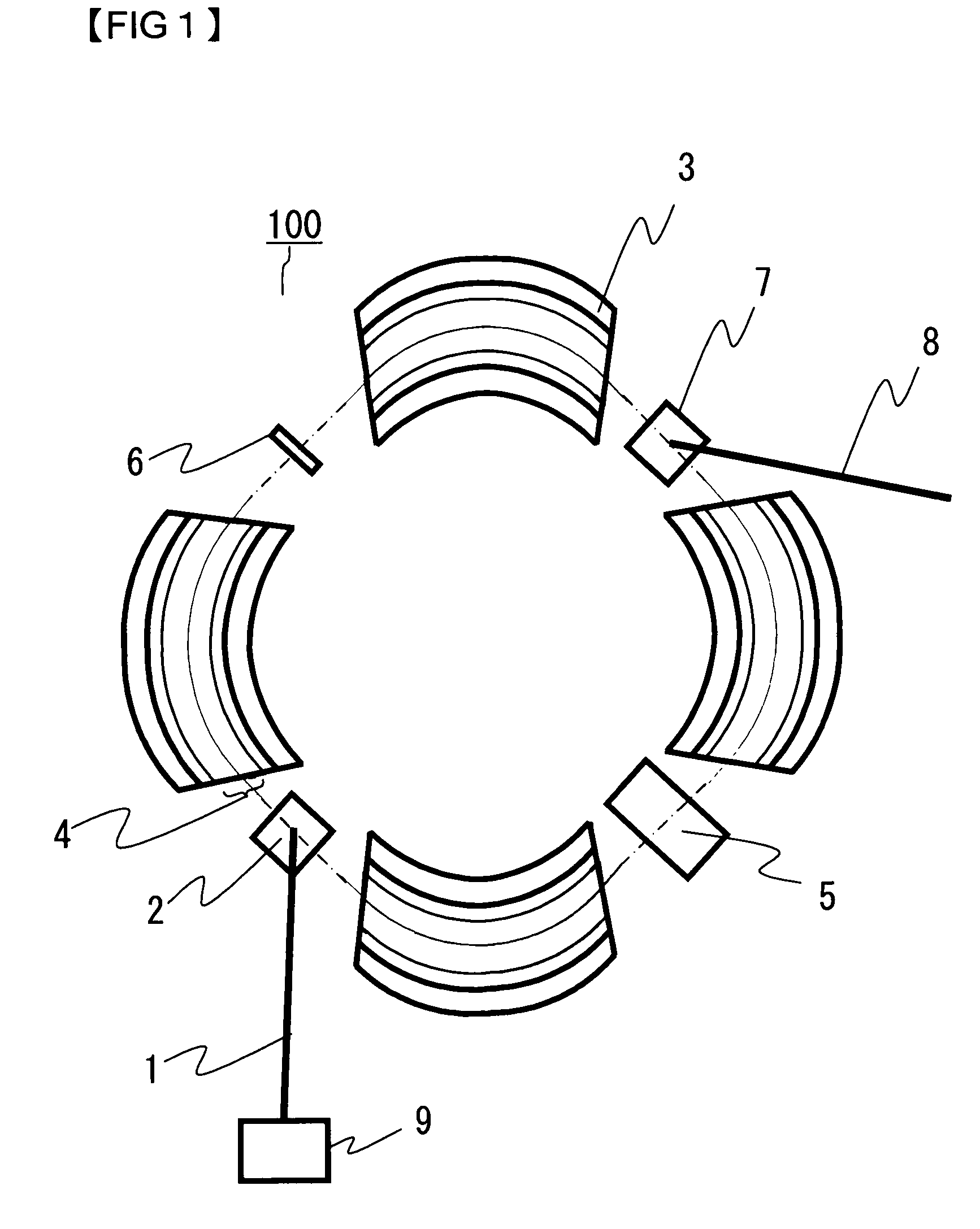Circular accelerator
a technology of accelerators and beams, applied in accelerators, direct voltage accelerators, electric discharge tubes, etc., can solve the problems of long time expended, unstable beam outside the separatrix, and long time expended on the adjustment of emission parameters, so as to reduce the cost, shorten the beam adjustment time, and simplify the control
- Summary
- Abstract
- Description
- Claims
- Application Information
AI Technical Summary
Benefits of technology
Problems solved by technology
Method used
Image
Examples
first embodiment
[0031]The first embodiment of this invention will be described in conjunction with the drawings.
[0032]FIG. 1 is a view showing the equipment arrangement of a circular accelerator 100 according to the first embodiment. As is extensively known, the circular accelerator 100 is such that charged particles entered from a prestage accelerator 9 and through a beam transport system 1 are accelerated while being revolved around an equilibrium orbit 4 which is a revolving orbit, and that the charged particles are thereafter fed into an irradiation chamber, not shown, through an emission device 7 as well as an emitting beam transport system 8.
[0033]As shown in FIG. 1, the circular accelerator 100 includes an entrance device 2 which enters the beam of the charged particles, for example, protons transported from the prestage accelerator 9, a high-frequency acceleration cavity 5 which gives energy to the charged particles, bending electromagnets 3 which bend the beam orbit, a six-pole electromagn...
second embodiment
[0051]Next, a second embodiment will be described with reference to FIG. 10 which is a partial enlarged view of a magnetic pole edge portion 32.
[0052]As shown in FIG. 10, the length L1 of the first protrusion 34a of the endpack 34 and the length L2 of the second protrusion 34b are equalized, and the inclination angles are set to be θ2>θ1. That is, the flat parts 34d and 34e of the first and second protrusions 34a and 34b are identical, and the inclination angles θ1 and θ2 are not identical. Besides, the initial point S1 of the first equilibrium-orbit-side end part K1 of the first protrusion 34a is set to lie radially inside the equilibrium orbit 33b of a higher energy beam, and the initial point S2 of the second equilibrium-orbit-side end part K2 of the second protrusion 34b is set to lie radially outside the equilibrium orbit 33c of a lower energy beam.
[0053]The endpack 34 having such first and second protrusions 34a and 34b is additionally provided, whereby the energy dependency o...
third embodiment
[0054]A third embodiment will be described with reference to FIG. 11 which is a partial enlarged view of a magnetic pole edge portion 32.
[0055]As compared with FIG. 10 of the second embodiment, FIG. 11 differs only in the fact that the initial points of the first and second equilibrium-orbit-side end parts K1 and K2 of the first and second protrusions 34a and 34b of the endpack 34 are set at the intersection point S between these end parts and the equilibrium orbit 33a of a center energy beam. The others are the same as in FIG. 10.
[0056]Also in this case, the energy dependency of the tune can be made linear in the same manner as in the first embodiment. Accordingly, emission parameter adjustments at the change of energy are simplified, and an initial beam adjustment period can be sharply shortened.
PUM
 Login to View More
Login to View More Abstract
Description
Claims
Application Information
 Login to View More
Login to View More - R&D
- Intellectual Property
- Life Sciences
- Materials
- Tech Scout
- Unparalleled Data Quality
- Higher Quality Content
- 60% Fewer Hallucinations
Browse by: Latest US Patents, China's latest patents, Technical Efficacy Thesaurus, Application Domain, Technology Topic, Popular Technical Reports.
© 2025 PatSnap. All rights reserved.Legal|Privacy policy|Modern Slavery Act Transparency Statement|Sitemap|About US| Contact US: help@patsnap.com



